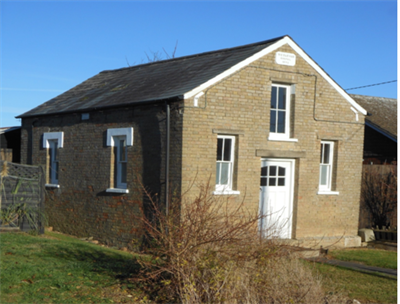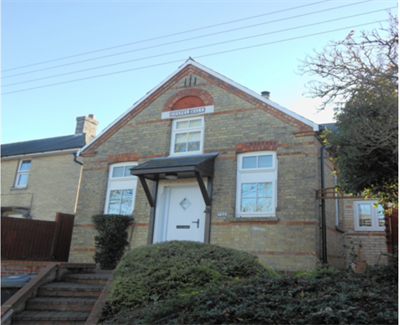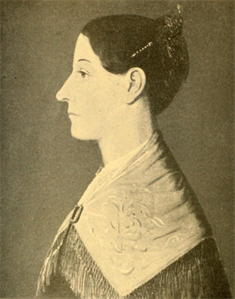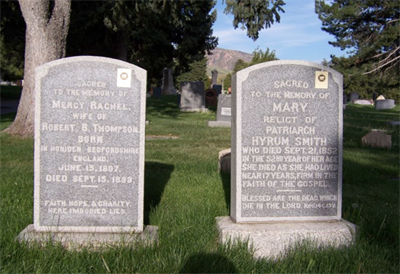From Staploe to Salt Lake City
A Tale of Pioneers from a Tiny Bedfordshire Community
This page was contributed by Trevor Stewart
The impact of the Mormon religion on the growth and development of the United States of America is well documented. What is perhaps less well known is the significant part that a small Bedfordshire community also played in this story.

Former chapel at Honeydon
The civil parish of Staploe lies on the County Boundary to the north east of Bedford. It is made up of a number of small hamlets, among them Bushmead, Colesden, Basmead, Duloe and Honeydon. Although tiny and relatively isolated communities, during the 18th. and 19th centuries these were a hot bed of non conformity. The new Wesleyan and Methodist religions initially met in private houses, but rapidly grew in popularity and despite a residency of below 100, each of these hamlets finally had its own free church, chapel or Gospel Hall. Those at Honeydon built in 1872 (held 50 people) and Staploe, built 1884 (also 50 people), still stand. Records show that these chapels were full several times every Sunday and for meetings during the week, suggesting that almost the entire population were active in the Free Church or dissenting movement.
In 1793 John Fielding was a popular Methodist preacher in Halifax, Yorkshire. A relative who owned several estates in Bedfordshire offered John and his wife Rachel the tenancy of one of these farms in Honeydon, then spelt Honidon. John who was very interested in farming visited to see what sort of future it may hold for his family and found it to be a ‘’less than hospitable place’’. He intended to return immediately to Halifax but while at the farm he opened his bible and his eye was immediately drawn to a particular passage of scripture which he took to be a sign. He concluded that it was God’s will that Honeydon should be their future home though he still did not consider that he could return to Yorkshire with "a favourable report’’ as to his visit. Rachel therefore remained wholly opposed to any move but eventually after a great deal of thought she agreed to come south and the family arrived in Bedfordshire in the middle of May 1794.
The Fieldings had exchanged a busy life in an expanding city for a lonely village and a small inconvenient cottage, and a large circle of friends for a place where they were totally unknown. Rachel would gladly have returned to the area of her birth but she remained loyal to her husband and over the years became very popular in her adopted community where ‘’She cared for the sick and the poor and always lived a godly life’’. She ran the home and much of the farm leaving her husband to attend to his numerous preaching duties, often as many as twenty or thirty miles away and it was into this background that further children were born.

Staploe Gospel Hall
In 1832 a group of six villagers from Staploe emigrated to Charleton near Toronto in Canada, a very major decision for the time, but their harsh life on the poor quality land had become intolerable and there was little hope for a better future. Among those making this journey were John’s son Joseph Fielding and his sister Mercy Rachel, and they were to be joined two years later by their younger sister, Mary Ann.
Another sister Ann had married the Curate of nearby Bolnhurst and Colmworth the Rev. Timothy Matthews, who was himself to become an important character in the religious history of Bedford.
On their arrival in Canada the group began to attend Mormon Bible Classes and Meetings and finding themselves increasingly drawn to the faith they all moved in 1837 to the newly established Mormon community at Kirtland, Ohio. Joseph having lately become a fully baptized member of the Church was then sent back to England with a party of 12 missionaries to gain more converts.
It was at Kirtland that Mary met Hyrum Smith the joint leader and recently widowed elder brother of the founder of the Mormon faith. She married Hyrum on 24th December 1837 thereby accepting responsibility for his six children and later giving birth to two more of her own - Joseph Fielding Smith and Martha Ann Smith.
Timothy Matthews, Joseph’s brother in law, had moved from Colmworth to Bedford in 1830 and had gained something of a reputation as a rebel . He had numerous disagreements with the established church of which he was still an ordained minister but who it appears considered him “great evangelist, controversial, and the most unconventional figure of his time - a law unto himself.’’ With the help of his large congregation, he had physically built his own ‘’unlicensed’’ church in Bromham Road. It was perhaps not surprising therefore that Joseph, who had reached Bedford via Liverpool and Preston (and a less than hospitable greeting from his brother John, then living at Graveley near St. Neots) did receive a very warm welcome from Timothy who also offered him the opportunity to use his church and said that he “was proud to be seen walking in town with the representatives of this new faith.”
By the time that Joseph returned to America in 1841, the English membership of the Mormon church had increased to 7000, in 20 different branches. Indeed the steamship Tyrian, on which Joseph travelled carried 207 passengers, all supporters who wished to become full time members of the community. This exodus continued several times a year over subsequent years.
Things had not gone well in Kirtland however and the hoped for ‘’promised land’’ had not been realized. In fact, riots and disputes with non supporters had caused the first major trek from Kirtland out to Nauvoo, Illinois in the autumn of 1837. While here, Hyrum and Joseph Smith heard rumors that they were about to be arrested and they fled to Cincinnati and later to Carthage, where they were indeed detained, charged with riot and treason and locked up in the local jail. Here on 27th June 1844 both were murdered during a rampage by a violent mob who destroyed the prison. This incident is still referred to as the ‘’martyrdom’’ by the Mormon church.
It had been hoped that Nauvoo might become a long term settlement but after the murder it was agreed by the elders of the community that various groups of pioneers should again be sent out to search for what the whole faith could consider to be a permanent spiritual home. Word of the murder of her husband having reached the widowed Mary she determined to stay at Nauvoo with her two youngest children to await a divine message as to their own future.

Mary Fielding Smith
From March 1846, and hastened by events, groups of pioneers began trekking from Nauvoo in all directions in an effort to find the promised land and the first proper and well organized wagon trains left later that year. During 1846 Mary also left Nauvoo to stay at the winter quarters of the faith which had been established in North Omaha some 200 miles away and by April the following year she had joined a group led by Brigham Young heading for the fertile plains of Utah. This Group consisted of 143 men, 3 women, and 2 children using 73 wagons and taking 93 horses, 52 mules, 66 oxen, 19 cows, 17 dogs and carrying enough food and supplies to last for one year.
The leaders of the Group did not want to take Mary as they felt that a woman on her own with two very young children would delay them. They also said that Mary was not well enough to make the long, hazardous journey. She argued that with or without their help she would go and offered the further challenge that she would get to Utah before the rest of the Group. After many difficulties, dangers and setbacks, including the loss of all of her stock and possessions, and almost 18 months of constant travel, she did actually arrive in Salt Lake Valley on 22nd September 1848, a couple of days ahead of the main party.
They had all walked, overcoming enormous hardships, some towing hand carts, between 14 to 20 miles every day except Sundays, a journey of some 1500 miles across all types of terrain including the Rocky Mountains. By December of that year a further 2000 had made the trek and the construction of Salt Lake City had begun in earnest.
Mary and her family built a small two roomed cottage just outside the city where she lived until her death on 21st September 1852. The cottage is preserved in the pioneer village museum in the City and Mary is still greatly revered, admired and respected throughout America especially within the Mormon community, as a model of courage, enterprise and faithfulness. She is buried in Salt Lake City cemetery.

Graves of Mercy Rachel Thompson and Mary Fielding Smith (from Wikipedia under Creative Commons License, © Ryan Reeder)
Thus a 31 year old girl from a tiny Bedfordshire hamlet, became one of America’s greatest pioneers, the wife of one leader of the Mormon faith, the mother of another (her son Joseph became the 6th President of the Church in October 1901), and the grandmother of yet another, Joseph Fielding Smith, who became 10th President in January 1970.
As for today, sadly the cottage in Honeydon fell down in 1947, but some farm buildings of John Fielding’s tenancy remain. Timothy Matthews church in Bromham Road still stands but is now Esquires Night Club.
The graves of John and Rachel Fielding can be seen in Colmworth Churchyard as can the table tomb of Matthews who was originally buried in the grounds of his ‘’own’’ church, but was subsequently moved to the place where he had first ministered.
‘’the Pioneers are a people peculiar to our country,
they live of choice in the forest and
they are unwilling to submit to the restraints of society…
they are brave, patient of fatigue and capable of
enduring wonderful hardships…..
they are honest and very generous.
Crimes of magnitude seldom occur among them’’
American Quarterly Review 1848.